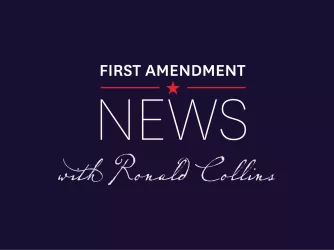Table of Contents
George Washington’s Response to Swastika Earns Media Scrutiny

Earlier this week, FIRE reported on The George Washington University’s (GWU’s) suspension of a Jewish student who displayed a Hindu swastika he brought back with him from a trip to India on his residence hall’s bulletin board. Charging the student with five conduct code violations, the university ignored the swastika’s long tradition as a symbol of good luck. In so doing, GWU ignored its own promises of free expression, as well as FIRE’s March 27 letter arguing that it must rescind its punishment of the student.
Many commentators have since written publicly to explain that the mere display of a swastika cannot be punished consistent with free speech principles. Ohio University professor Richard Vedder took to Forbes yesterday to detail the history of the symbol—precisely what the GWU student was intent on teaching his peers:
The swastika has been used for thousands of years in both decorative and religious connotations. The Hindu swastika is similar to, but also distinctly different from the one used by Hitler’s minions in the 1930s and 1940s. Other swastikas are used by Buddhists and in particular by those of the Jain religion.
As Vedder points out, “this banning received widespread attention in India, where some viewed it as an anti-Indian and anti-Hindu act.” Indeed, earlier today the case received coverage in India Today, where readers were reminded that the Indian swastika is “a sacred symbol for Hindus and Buddhists.”
The Diplomat’s Akhilesh Pillalamarri provided more context to drive the point home: Swastikas do not belong to the Nazis. “[I]t is ubiquitous in Buddhist and Hindu countries,” he writes, “used in Jainism and Zoroastrianism[,] and can be seen in stores in India, temples in Japan, and art in China. … In addition to being found in Asian cultures, the swastika was (is) also used in Native American cultures, multiple European cultures—Roman, Greek, Celtic, Slavic, Germanic, Finnish—the Middle East, Africa, and even in Jewish art.” Treating the display of a swastika as a punishable offense, Pillalamarri contends, amounts to an application of “reductio ad Hitlerum”: the idea that “any view or interest shared with Hitler is evil, whether it be liking dogs, enjoying classical music, constructing good roads, or being a vegetarian.”
Why does this history matter? After all, a Nazi sympathizer is no less protected by the First Amendment than someone celebrating Hinduism or Buddhism, and he or she should be no less protected under GWU’s explicit promises of freedom of expression. Well, among the university’s charges against the student who hung the swastika was an allegation that he violated a law concerning the “Nazi swastika.” FIRE’s letter explains:
Included with the disciplinary charges was a copy of District of Columbia Code § 22-3312.02, titled “Defacing of burning cross or religious symbol; display of certain emblems,” which serves as the foundation for the “Violation of Law” charge. This code provision prohibits, in part, the placement or display of “a Nazi swastika” on any public property and certain private property,
where it is probable that a reasonable person would perceive that the intent is:
[ . . . ]
(3) To threaten another person whereby the threat is a serious expression of an intent to inflict harm; or
(4) To cause another person to fear for his or her personal safety, or where it is probable that reasonable persons will be put in fear for their personal safety by the defendant’s actions, with reckless disregard for that probability.
As FIRE’s letter argues, this statute doesn’t prohibit the student’s hanging of his Indian souvenir. The swastika’s source and (more evidently to those viewing it) its orientation on the board demonstrate that it wasn’t a Nazi swastika. And because it was displayed without any other indication of its purpose, it would not be reasonable to infer that it was meant as a threat.
GWU’s application of the statute has another problem, though—it is inconsistent with the Supreme Court’s past rulings on the boundaries of free expression. FIRE wrote in our letter:
[T]he code establishes a broader definition of prohibited “intimidation” than Supreme Court precedent allows. The Supreme Court has defined constitutionally proscribable intimidation as speech “where a speaker directs a threat to a person or group of persons with the intent of placing the victim in fear of bodily harm or death.” Virginia v. Black, 538 U.S. 343, 360 (2003). But whereas the Court’s definition requires intent on the part of the speaker, the D.C. ordinance prohibits display of a swastika where a reasonable person would perceive that the speaker intended to place the victim in fear for their “personal safety.” Because the D.C. Code prohibits speech based on the perception of the speaker’s intent rather than the speaker’s actual intent, it proscribes more speech than the First Amendment permits.
In short, GWU’s punishment of a student for displaying a swastika completely devoid of Nazi-related context is worthy of censure on several levels. FIRE is glad to see we are not alone in remarking on the negative effect that the university’s actions might have on unfettered debate and open discussions on campus.
Recent Articles
FIRE’s award-winning Newsdesk covers the free speech news you need to stay informed.

No president gets to decide who deserves a lawyer

Free speech in an age of fear: The new system loyalty oaths – First Amendment News 464

AI is new — the laws that govern it don’t have to be
